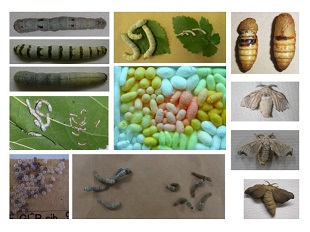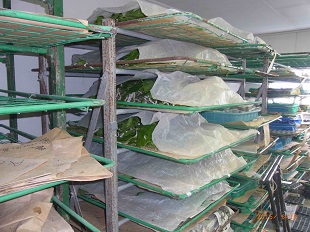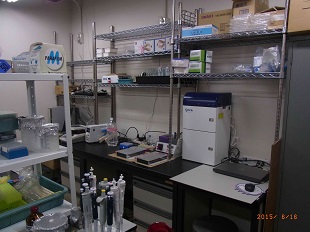カイコの有用突然変異遺伝子の単離と機能解析

メンバー: 横山岳、伊藤克彦
分野: 境界農学、動物生命科学、生産環境農学
所属: 農学研究院
キーワード: カイコ、突然変異、昆虫遺伝、昆虫生理、昆虫病理
ウェブサイト:
研究概要

カイコは長い年月をかけて人間の手によって家畜化された特異な昆虫です。その長い歴史のなかで、これまでに500を越える様々な表現型を示す突然変異体が発見されていましたが、その原因遺伝子については明らかになっていませんでした。しかし近年、カイコのゲノム解析が急速に進み、ほぼ全ゲノムの塩基配列が明らかにされた他、数万を超える発現遺伝子情報のデータベース化や遺伝子改変カイコの作出技術ならびに遺伝子操作技術の確立によって、遺伝子を特定できる状況になってきました。
研究室では、このゲノム情報を使って「カイコの有用突然変異遺伝子の単離と機能解析」を進めています。特に、致死に関わる突然変異遺伝子を解析することで、昆虫の生育に関わる重要な生理活性物質やカスケードを明らかにしていくことを目的としています。これまでに単離されているいくつかの致死変異体では、機能解析の結果、昆虫の生命現象にとどまらず、哺乳類の遺伝病のモデルとして利用できる可能性が示唆されています。よって、これから単離を試みる致死遺伝子に関しても、このような可能性を探求したいと考えております。また、カイコに特異的に感染するカイコ濃核病ウイルスの感染機構の解明についても研究を進めています。カイコがもつウイルス感染決定因子(ウイルス抵抗性/感受性遺伝子)を明らかにし、それがウイルス感染にどのように作用しているのかを調査することで、カイコ濃核病ウイルスの感染機構を解明していくことが目的です。これらの致死や罹病性に関わる原因因子を突き止めることで昆虫の「弱点」を明らかにし、害虫防除への応用を目指しています。
主要論文・参考事項
1) Gupta T, Kadono-Okuda K, Ito K, Ponnuvel KM (2015) Densovirus infection in silkworm Bombyx mori and genes associated with disease resistance. Invertebrate Survival Journal, 12: 118-128.
2) Nojima Y, Ito K, Ono H, Nakazato T, Bono H, Yokoyama T, Sato R, Suetsugu Y, Nakamura Y, Yamamoto K, Satoh J, Tabunoki H, Fugo H (2015) Superoxide Dismutases, SOD1 and SOD2, Play a Distinct Role in the Fat Body during Pupation in Silkworm Bombyx mori. PLoS One. 10. e0116007.
3) Polan SM, Ito K, Miyamoto K, Yokoyama T, Ninagi O (2014) Linkage analysis of the resistance gene expressed dominantly against the Bt insecticide Cry1Ac in the Silkworm Bombyx mori. J. Insect Biotechnol. Sericol. 83 (2): 33-39.
4) Kadono-Okuda K, Ito K, Nurthy GN, Sivaprasad V, Ponnuvel KM (2014) Molecular mechanism of densovirus resistance in silkworm, Bombyx mori. Sericologia 54(1): 1-10.
5) Ito K, Kidokoro K, Shimura S, Katsuma S, Kadono-Okuda K (2013) Detailed investigation of the sequential pathological changes in silkworm larvae infected with Bombyx densovirus type 1. J Invertebr Pathol 112(3): 213-218.
6) Ito K, Kidokoro K, Katsuma S, Shimada T, Yamamoto K, Mita K, Kadono-Okuda K (2012) Positional cloning of a gene responsible for the cts mutation of the silkworm, Bombyx mori. Genome 55(7): 493-504.
7) Niwa R, Namiki T, Ito K, Shimada-Niwa Y, Kiuchi M, Kawaoka S, Kayukawa T, Banno Y, Fujimoto Y, Shigenobu S, Kobayashi S, Shimada T, Katsuma S, Shinoda T (2010) Non-molting glossy/shroud encodes a short-chain dehydrogenase/reductase that functions in the "Black Box" of the ecdysteroid biosynthesis pathway. Development 137(12): 1991-1999.
8) Kidokoro K, Ito K, Ogoyi O. D, Abe H, Mita K, Kadono-Okuda K (2010) Non-susceptibility genes to Bombyx densovirus type 1, Nid-1 and nsd-1, affect distinct steps of the viral infection pathway. J Invertebr Pathol 103(1): 79-81.
9) Ito K, Katsuma S, Yamamoto K, Kadono-Okuda K, Mita K, Shimada T (2010) Yellow-e determines the color pattern of larval head and tail spots of the silkworm, Bombyx mori. J Biol Chem 285(8): 5624-5629.
10) Ito K, Katsuma S, Yamamoto K, Kadono-Okuda K, Mita K, Shimada T (2009) A 25 bp-long insertional mutation in the BmVarp gene causes the waxy translucent skin of the silkworm, Bombyx mori. Insect Biochem Mol Biol 39(4): 287-293.
11) Ito K, Kidokoro K, Sezutsu H, Nohata J, Yamamoto K, Kobayashi I, Uchino K, Kalyebi A, Eguchi R, Hara W, Tamura T, Katsuma S, Shimada T, Mita K, Kadono-Okuda K (2008) Deletion of a gene encoding an amino acid transporter in the midgut membrane causes resistance to a Bombyx parvo-like virus. Proc Natl Acad Sci USA 105(21): 7523-7527.
お問い合わせ先
東京農工大学・先端産学連携研究推進センター
urac[at]ml.tuat.ac.jp([at]を@に変換してください)
Positional cloning and functional analysis of the useful mutant genes in Bombyx mori

Research members: Dr. Takeshi Yokoyama, Dr. Katsuhiko Ito
Research fields: Boundary agriculture, Animal life science, Plant production and environmental agriculture
Departments: Institute of Agriculture
Keywords: silkworm, mutation, insect genetics, insect physiology, insect pathology
Web site:
Summary

Silkworm is a unique insect which have been domesticated by breeding for a long time. In the history, more than 500 mutants have been reported so far, however, their responsible genes have not been identified yet. Currently, the Bombyx genomic information has been updated day by day, for example 1) almost a complete genomic sequence of silkworm was published, 2) the expressed genes over several tens of thousand were compiled into database, and 3) a transgenic and genome engineering techniques were established. These information and techniques were powerful tool for analysis of the mutant gene in Bombyx. In this background, our laboratory is performed the “Positional cloning and functional analysis of the useful mutant genes in Bombyx mori”. One of the objectives of our study is the investigation of the important bioactive substance and cascade for the insect growth using the lethal mutation. In addition, another research theme is the analysis of the infection mechanisms of Bombxy mori densovirus which is a pathogen causing flacherie disease in silkworms. The aim of this study is the investigation of the relationship between resistance/susceptible genes for Bombxy mori densovirus and virus infection. To identify these genes responsible for lethality and susceptibility, we would like to find a “weak points” of insect, and apply it as the target factor of pest control.
Reference articles and patents
1) Gupta T, Kadono-Okuda K, Ito K, Ponnuvel KM (2015) Densovirus infection in silkworm Bombyx mori and genes associated with disease resistance. Invertebrate Survival Journal, 12: 118-128.
2) Nojima Y, Ito K, Ono H, Nakazato T, Bono H, Yokoyama T, Sato R, Suetsugu Y, Nakamura Y, Yamamoto K, Satoh J, Tabunoki H, Fugo H (2015) Superoxide Dismutases, SOD1 and SOD2, Play a Distinct Role in the Fat Body during Pupation in Silkworm Bombyx mori. PLoS One. 10. e0116007.
3) Polan SM, Ito K, Miyamoto K, Yokoyama T, Ninagi O (2014) Linkage analysis of the resistance gene expressed dominantly against the Bt insecticide Cry1Ac in the Silkworm Bombyx mori. J. Insect Biotechnol. Sericol. 83 (2): 33-39.
4) Kadono-Okuda K, Ito K, Nurthy GN, Sivaprasad V, Ponnuvel KM (2014) Molecular mechanism of densovirus resistance in silkworm, Bombyx mori. Sericologia 54(1): 1-10.
5) Ito K, Kidokoro K, Shimura S, Katsuma S, Kadono-Okuda K (2013) Detailed investigation of the sequential pathological changes in silkworm larvae infected with Bombyx densovirus type 1. J Invertebr Pathol 112(3): 213-218.
6) Ito K, Kidokoro K, Katsuma S, Shimada T, Yamamoto K, Mita K, Kadono-Okuda K (2012) Positional cloning of a gene responsible for the cts mutation of the silkworm, Bombyx mori. Genome 55(7): 493-504.
7) Niwa R, Namiki T, Ito K, Shimada-Niwa Y, Kiuchi M, Kawaoka S, Kayukawa T, Banno Y, Fujimoto Y, Shigenobu S, Kobayashi S, Shimada T, Katsuma S, Shinoda T (2010) Non-molting glossy/shroud encodes a short-chain dehydrogenase/reductase that functions in the "Black Box" of the ecdysteroid biosynthesis pathway. Development 137(12): 1991-1999.
8) Kidokoro K, Ito K, Ogoyi O. D, Abe H, Mita K, Kadono-Okuda K (2010) Non-susceptibility genes to Bombyx densovirus type 1, Nid-1 and nsd-1, affect distinct steps of the viral infection pathway. J Invertebr Pathol 103(1): 79-81.
9) Ito K, Katsuma S, Yamamoto K, Kadono-Okuda K, Mita K, Shimada T (2010) Yellow-e determines the color pattern of larval head and tail spots of the silkworm, Bombyx mori. J Biol Chem 285(8): 5624-5629.
10) Ito K, Katsuma S, Yamamoto K, Kadono-Okuda K, Mita K, Shimada T (2009) A 25 bp-long insertional mutation in the BmVarp gene causes the waxy translucent skin of the silkworm, Bombyx mori. Insect Biochem Mol Biol 39(4): 287-293.
11) Ito K, Kidokoro K, Sezutsu H, Nohata J, Yamamoto K, Kobayashi I, Uchino K, Kalyebi A, Eguchi R, Hara W, Tamura T, Katsuma S, Shimada T, Mita K, Kadono-Okuda K (2008) Deletion of a gene encoding an amino acid transporter in the midgut membrane causes resistance to a Bombyx parvo-like virus. Proc Natl Acad Sci USA 105(21): 7523-7527.
Contact
University Research Administration Center(URAC),
Tokyo University of Agriculture andTechnology
urac[at]ml.tuat.ac.jp
(Please replace [at] with @.)


